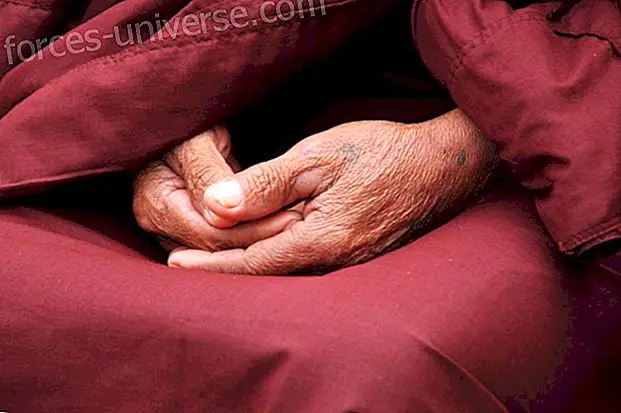Interview with Sayadaw U Pandita: Instructions for the practice of Vipassana meditation (Part 1)
- 2018

Your worst enemy cannot harm you as much as your own thoughts.
Buddha
Vipassana meditation is one of the oldest practices in the Buddhist tradition. Its meaning is something like see reality in its true nature . It is believed that this form of meditation was the one taught by the Buddha himself, and although the specific way of carrying out this practice may vary, it is the basis of meditation. No Buddhist in its entirety.
He began writing this article to explain the basis of this practice, but he thought it best to read it from the words of grandmaster Sayadaw U Pandita (1921-2016), student of the Venerable Mahasi Sayadaw of Burma . Pandita is one of the world's leading Vipassana meditation leaders. He is also the founder of the Panditarama Meditation Center in Yangon, Myanmar.
In this first part of the interview with Sayadaw U Pandita extracted from nibanna.com, we will delve into the practice of this meditation in the sitting position.
Vipassana: How and where to sit
1. What place is the best for meditation?
The Buddha suggested that both under a tree in a green place and in any quiet place is the best for meditation.
2. How should the practitioner sit down?
He (the Buddha) said that the apprentice should sit in complete stillness and peacefully with his legs crossed.
3. How should those with back problems sit?
If sitting cross-legged is too difficult, other sitting positions can be used. For those with back problems, a chair may be acceptable. Either way, they should sit with their right back, forming a right angle to the floor but not too rigid.
4. Why should they sit straight?
The reason to sit straight is not very difficult to see. An arched and crooked back will be the occasion of pain quickly. In addition, the physical effort to remain upright without additional support gives more energy to the practice of meditation.
5. Why is it important to choose a position?
To achieve peace of mind, we must ensure that our body is at peace. That is why it is important to choose a position that is comfortable for a long period of time.
Vipassana: The breath
6. After sitting down, what should be done?
Close your eyes. Then put your attention on the belly, on the abdomen. Breathe normally — without forcing your breath — no more slowly or holding it back. Just a natural breath.
7. What will you begin to notice while inspiring and exhaling?
You will begin to notice certain sensations as you inspire and the abdomen expands, and then as you exhale and the abdomen contracts.
Vipassana: Developing attention
8. How should you improve the intention?
Improve it by making sure that your mind is attentive to the total of each process. Pay attention from the beginning of any sensation involved in inspiration. Keep your attention still during the middle and the end of your inspiration. Then, pay attention to the sensations of the lowering of your abdomen from the beginning, during the middle and until the end of the expiration.
Although we describe inspiration and exhalation as if they had a beginning, a middle and an end, this is only to indicate that your attention should be continuous and constant. There is no intention to separate these processes into three segments. You should be aware of each of these movements from the beginning to the end as a complete process, an integer. Do not observe the sensation with an over-concentrated mind, especially seeking to discover how abdominal movements begin and end.
9. Why are both effort and intention important in this meditation?
Both effort and a precise intention are very important so that the mind meets the sensation directly and powerfully.

10. What can be a way to help our precision and accuracy?
One way that helps is to maintain a mental indication of what is the object of our attention, naming the sensation with a gentle and silent voice in our mind, as “inspiration, inspiration. . . ”, And“ exhalation, exhalation. . . ”
11. When the mind wanders, what should we do?
Look at the mind. Pay attention to what you are thinking.
12. How can you make your awareness of your thoughts clearer?
Indicate the thought silently with the verbal label "thinking", and return again to the sensation of your breathing.
13. Is it possible to remain perfectly focused on the movements of the abdomen all the time?
Unless an effort is made to achieve it, no one can remain perfectly focused on the movements of the abdomen forever. Other objects inevitably arise and become predominant. However, meditation accompanies all our experiences: visions, sounds, smells, flavors, sensations in the body and mental objects such as imagination or emotions. When any of these objects arises you must focus our attention directly on it, and silently and gently use a verbal label.
Vipassana: During practice
14. If other objects impact your attention and attract it away from your breath, what should you do?
During sitting meditation, if another object impacts so strongly on the attention that it distracts it away from the movements of the abdomen, this object must be clearly indicated. For example, if a sound arises during your meditation, consciously direct your attention to that sound as soon as it appears. Pay attention to the sound as a direct experience, and also identify it concisely with a soft and internal verbal label listening, listening . When the sound decreases and ceases to be predominant, it returns to breathing. This is one of the basic principles to follow in sitting meditation.
15. What is the best way to use a verbal tag?
There is no need for complex language. A simple word is the best. For the entrances of the eyes, ears and tongue, simply say, looking, looking, seeing, listening or hearing, hearing, savoring, savoring, tasting
16. What are some ways to indicate sensations in the body?
For body sensations we can choose a more descriptive term such as calue, presi n, hardness or movement .
17. How should we indicate mental objects?
Mental objects seem to have a natural diversity, but in fact they fall into a few clear categories, such as thinking, imagining, recalling, planning and visualizing .
18. What is the purpose of labeling?
When you use the technique of etiquette, the goal is not to increase verbal skills. Labeling helps us to clearly perceive the true qualities of our experience. without being immersed in the content. Develop our mental power and concentration.
19. What kind of consciousness is sought in meditation, and why?
We seek a deep, clear, precise awareness of our mind and body. This direct awareness shows us the truth about our lives, the real nature of physical and mental processes.

Vipassana: Finishing the meditation
20. After an hour of sitting, do we reach the end of our meditation?
Meditation does not need to end after an hour of sitting. This can be carried continuously throughout the day.
21. How should we stop after a sitting meditation?
When you get up from the sitting position, you must indicate carefully, beginning with the intention of opening your eyes: "intention, intention ..."; "Opening, opening ..." Experience the mental event of intention and feel the sensations of opening your eyes. Continue to indicate carefully and precisely, with a full power of observation, through the total transition of postures until the moment you have stopped, and when you start walking.
22. In addition to sitting and standing, what else should we become aware of during the day?
Throughout the day you should also become aware — and indicate — all other activities, such as stretching, flexing your arms, closing your eyelids, eating, and so on. All these activities should be indicated with careful awareness and a soft mental label.
23. Is there a time of day when you should relax pure consciousness?
Outside of sleeping hours, you should try to keep pure consciousness carefully during all your hours of activity.
24. It seems to be a hard slogan to keep pure consciousness continuously throughout the day.
It is not a difficult task, it is just sitting and standing, and simply observing everything that happens to us.
Here ends the interview section related to sitting meditation.
I want to clarify that I have given myself the task of translating this interview from English as it appears on the nibanna.com website and I have had to make some decisions to translate some specific terms. However, I have always sought to express as faithfully as possible the original content and the meaning of what is said. I hope you find it interesting.
With the information that the great teacher Sayadaw U Pandita gives us here, we have enough to begin this ancestral activity. In future articles, I will finish this task of sending you this practical guide.
PART 1: interview-a-sayadaw-u-pandita-instructions-for-the-practice-of-meditation-vipassana-part-1 /
PART 2: interview-a-sayadaw-u-pandita-instructions-for-the-practice-of-vipassana-part-2 /
AUTHOR: Lucas, editor in the big family of hermandadblanca.org
SOURCES: http://www.myanmarnet.net/nibbana/pandita3.htm






